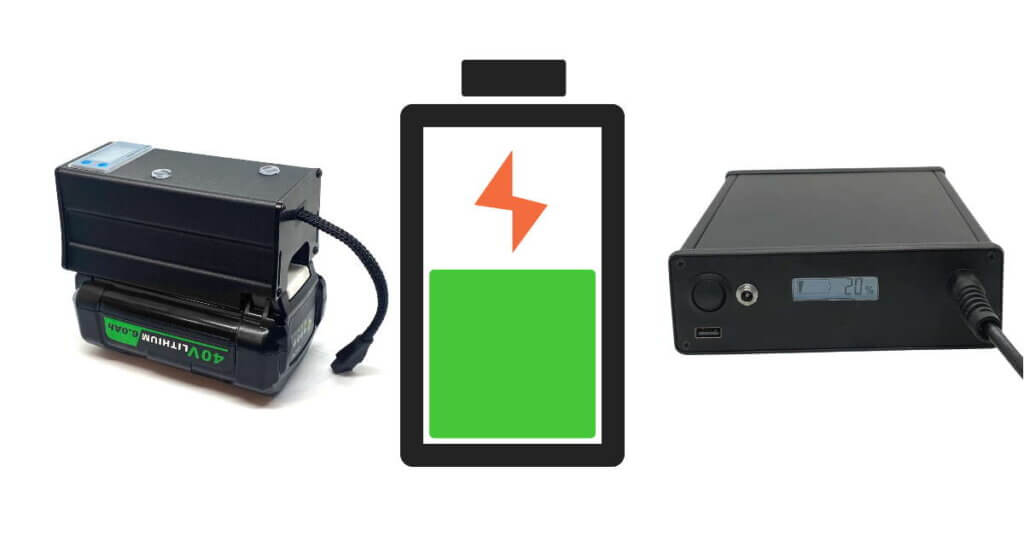Every rider has most likely come to a point where the battery is depleted but they still want to ride. Carrying a portable charger for your Onewheel is one way to charge your board during a meal or a small break. Something Onewheel Pint owners will feel more frequently with their lower battery capacity compared to the Pint X, XR, and now GT.
When it comes to portable chargers for the Onewheel there are three main tracks to go. Either charge from a portable power station with your regular charger, buy a dedicated portable charger for your specific model, or DIY a DC-DC booster to directly charge your board.
Using a portable charger has its benefits compared to other ways of increasing the battery capacity, VNR, or swapping the battery for a high-capacity one. Are you interested to go that route check out the battery extensions for the Onewheel Pint. There are some clear drawbacks, and adding an external battery or changing it will void your warranty. This is where a portable charger will play a key role, creating your own Onewheel charging station and it doesn’t void your warranty.
Disclaimer: Fallman Tech is not responsible for any damage to the board or person of anyone using a faulty or incompatible charger.
Portable Charger Station
A portable charging station for you Onewheel is the simplest way to charge the board on the go. It has some benefits compared to the other methods as it can be used to supply power to other appliances or applications when you are not using it for your Onewheel. They are mostly used in the camping community for giving power on the go but are perfect for you to create your own Onewheel charging station.
The drawback of this approach is that the system will have efficiency loss inverting the electric potential, volt, twice. First going from the internal battery to 120V AC – the charger adapter – 63 VDC. So you will not be able to use the full Watt-hours (Wh) stated on the station.
To get a full charge for a pint I would recommend looking at a system of around 185Wh. The Pint battery is rated at 63, 148Wh. For the Onewheel XR and Onewheel Pint X look for a system around 400Wh. To speed up the charging process it’s a good idea to get the high-power charger / ultra charger for the board. If using the ultra charger go with a higher power station to ensure that it can deliver the power needed for the charging process. The Jackery 240 is a good purchase that will deliver around 135% into a Pint.
When it comes to the output voltage of the inverter there are two common types of AC, pure sine or modified sine inverter. Go for a pure sine inverter as it corresponds to the normal output AC current in your home. A modified sine wave inverter can affect sensitive electronics and I would risk breaking your board by going cheap. The pure sine will be a bit more expensive, but still a lot cheaper than getting a new board. That being said, there are people getting results with modified sine wave inverters, it’s just not something we will recommend or take the risk.
Pros
- The most simple and common solution
- Safe – use the normal charger
- Includes multiple USB ports and outlets for other gear
Cons
- Compared to other solutions typically heavy
- You need your standard charger
- Dc->AC->DC is inefficient from an energy perspective
- Expensive ($300+)
If you are having your car you can get a car inverter and use the internal battery and motor of your car to charge the board. Be aware of not running down your 12v car battery and power the board with the engine running. Also, most care will only have a 10amp fuse making it only possible to charge with 120W from the port. Check out where you connect so this doesn’t happen to you, some cars have cigarette lighter ports that are higher fused for applications like this, or even a separate car battery to charge from.
The portable charging station uses a pure sine wave car inverter if you get one to keep the electronics inside the Onewheel safe. The downside is obviously that you will need to charge the board in your car, the good side is that you can top your battery while driving around.
*Warning never leave your board outside in the car if it’s freezing. The board and battery might die.
DC-DC charging system for the Onewheel
Avoiding inverting multiple times and fast charging is why there are battery banks like the CarvePower and ChiBatterySystems BoardBank. This gives both a boost in energy efficiency and charging speed compared to a portable charging station.
The downside is that as they are niche products in a niche market they are more expensive.
Pros
- Lightest solution
- (DC->DC) Most energy efficient
- Lots of battery choices if you get a barebone and add your own
- Offers the greatest control over capacity and rate of charge
Cons
- Expensive.
- Safety is dependent on the batteries used
CarvePower
Carvepower Slide Charger for the Onewheel uses normal Ryobi 40V tool batteries and boosts the voltage to 63V to charge your board. The price for a system for the Onewheel XR with one battery will come in at $225.00 giving you 208Wh. One battery can add around 9 miles of range, depending on the terrain. If you need more range or already have some spare Ryobi 40V tools, then you can use them to extend your ride.

You need to buy a board-specific version where the Pint version will charge at 3A, which is the same as the Pint Ultracharger, and the XR version will charge at 5A, which is near the speed of the XR Hypercharger.
The display shows the voltage and approximate capacity of the charger’s battery. It can also show the temperature inside the controller. The battery cases are printed polycarbonate with carbon fiber fill.
The single battery is 2.75″ x 5″ x 6″ and 3.75 lbs.
BoardBank
The Onewheel portable charger from ChiBatterySysytem, the BoardBank, is a model that is compatible with all Onewheels. It cost $530.00 for 500Wh capacity with an efficiency of 90% making it possible to utilize most of the stored energy. It’s a perfect mobile Onewheel charger for the Onewheel XR, giving the capability to fast charge the board 1.25 times.
Specs:
- 500 WH Capacity
- Output: Custom Range
- High-efficiency Energy Transfer (Over 90% efficient)
- Durable Port for charging
- Battery level display
- Durable enclosure protects contents from impacts
- Solid Aluminum construction
- Black Anodized Enclosure
- 8.65” x 6.50” x 2”
- 7 lbs (500 wh)
- USB Port for charging other devices
Per Device:
- OneWheel+ XR: Output 63 DCV @ 5A (Recharge 1.25 times, fast charging)
- OneWheel Pint: Output 63 DCV @3 A (Recharge 3 times, fast charging)
Checkout the BoardBank over att ChiBatterySystems
There is also a batteries-not-included version that you can use with standard hoverboard batteries from eBay. These batteries will not give you the same ranges but will come at a cheaper price.
DIY DC-DC portable charger
Going for a DIY DC-DC portable Onewheel charger there are usually two ways and it depends on the battery. Either you are getting some cheap batteries like the prebuilt barebone or utilizing commercially available tool batteries. The Too batteries will be a bit more expensive, the benefits are that you are getting better cells that can handle a higher discharge rate than the cheaper hoverboard battery packs out there.
Please be safe and only do this if you know what to do. DIY DC-DC will require soldiering and programming of the DC-DC converter. You are risking damaging the board if the supply voltage is incorrect.
IF YOU DO NOT HAVE THE KNOWLEDGE OF, AND COMFORT IN SAFE BUILDING PRACTICES, DO NOT PROCEED. BUILDING AND WORKING WITH LITHIUM-ION BATTERIES IS POTENTIALLY DANGEROUS AND CAN LEAD TO SEVERE INJURY AND DAMAGE.
Pros
- Cheaper
- Lightest solution
- (DC->DC) Most energy efficient
- Lots of battery choices
- Offers the greatest control over capacity and rate of charge
Cons
- Requires soldering.
- Safety is dependent on the batteries used
- Risk bricking the board.
DIY Onewheel portable charger
This build is a great starting point and will help you, but it requires you to have some knowledge about building electronic components. It’s not a guide on how to build batteries.
This guide utliszes a 1200W DC to DC Boost Converter and a selfmade battery pack. Building your battery is optional and I would not recommend anyone who doesn’t know what they do to be working with lithium-ion batteries.
Another great breakdown is this article. It like most DIY builds also uses a DC to DC Boost Converter, I recommend going with a higher output like the 1200W than the one specified in the article.
Tools Required:
- Soldering iron + solder
- Soldering station
- Screwdrivers
- Wire strippers
- Multimeter
Onewheel 18V Portable Battery Charger
You will need to find some 18V batteries and chargers, and ensure that the battery has an integrated BMS for under-voltage protection to prevent over-discharge. I recommend you to look into this guide for more details on the build over at Instructables.
You will need the FM car charger and a couple of spare batteries. 2×5.2 Ah, should charge the Onwheel Pint (148 Wh) and 4×5.2 the Onewheel XR (348Wh). The FM car charger outputs at an estimated 84% efficiency. If you have an XR I then most likely would look into other alternatives.
Tools Required:
- Soldering iron + solder
- Heatshrink
- Wire strippers
- Torx screwdriver set
- Lighter
- Multimeter
Conclusion
Getting a portable charger to charge the board on the go is great for somebody that wants to top off if you’re going to take a break, and doesn’t want to void the warranty. Getting the battery extension with VnR is a good option for people that want that continuous range and don’t mind voiding the warranty and potentially breaking things.
My recommendation for the best mobile Onewheel charger would be to get a dedicated DC-DC charger like the CarvePower. The benefit of using off-the-shelf tool batteries makes this a really versatile option for riders. For just a shorter day bring one spare battery and if you plan to ride longer bring a couple of extras.
If you are into backpacking and camping with a bit more heavy gear then a portable power station will give you some more options while not riding your board. Still, for only Onewheel charging, there are clear benefits with the DC-DC approach both in efficiency, weight, and charging speed.



